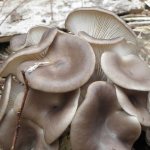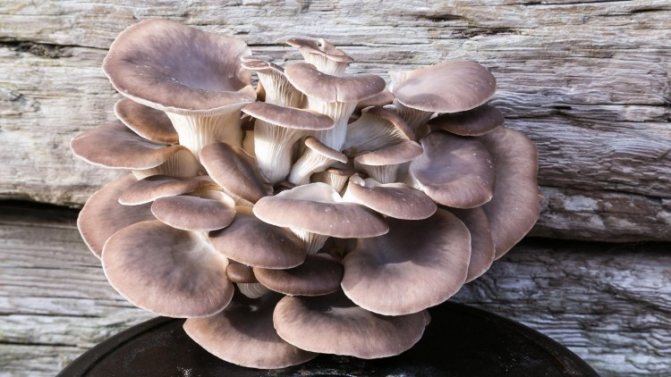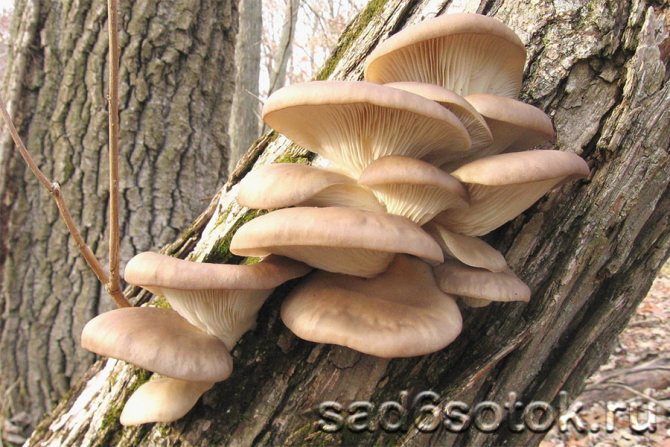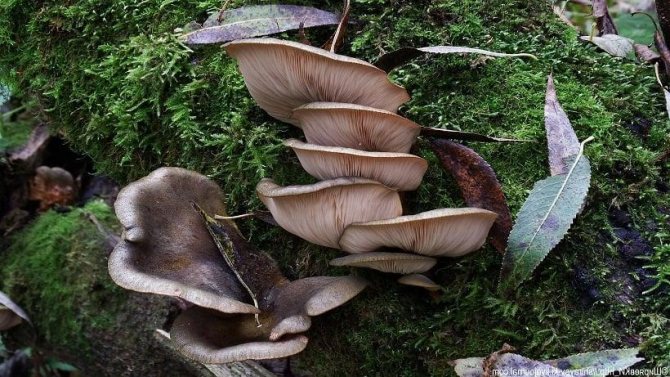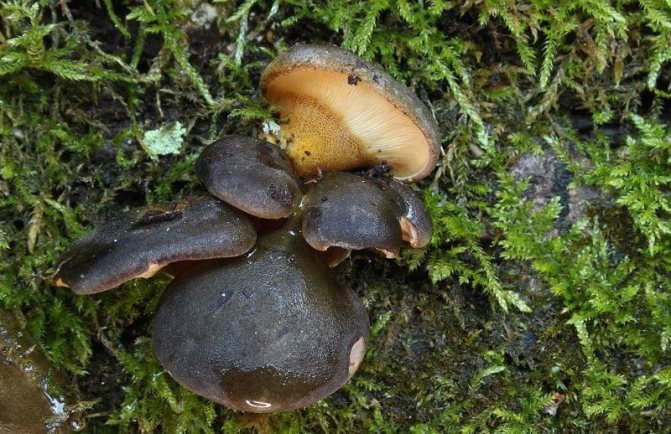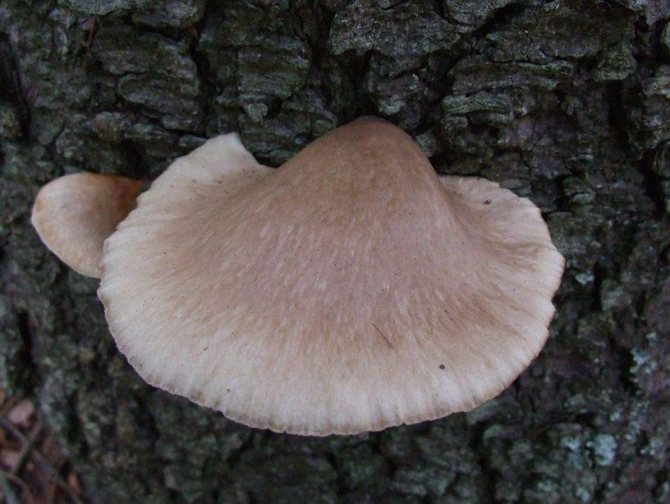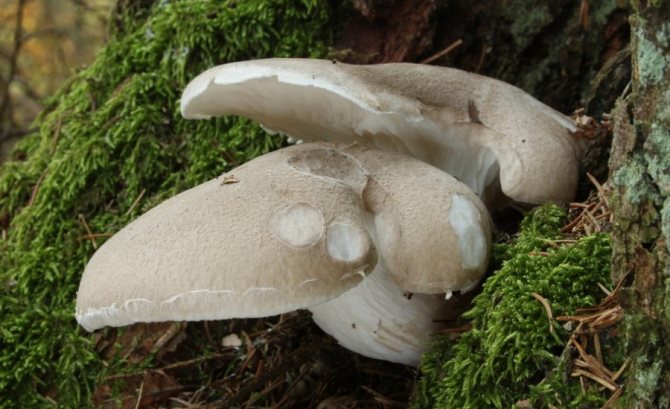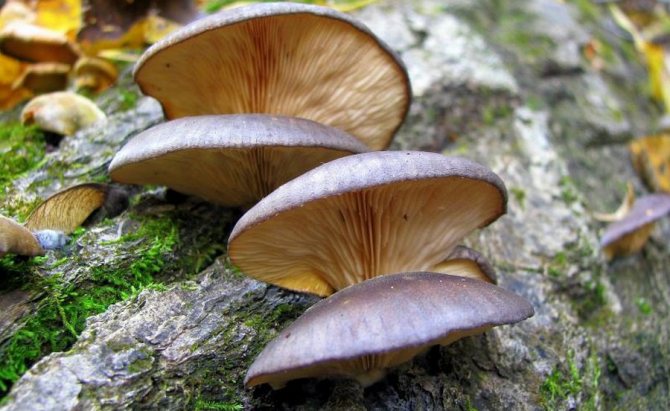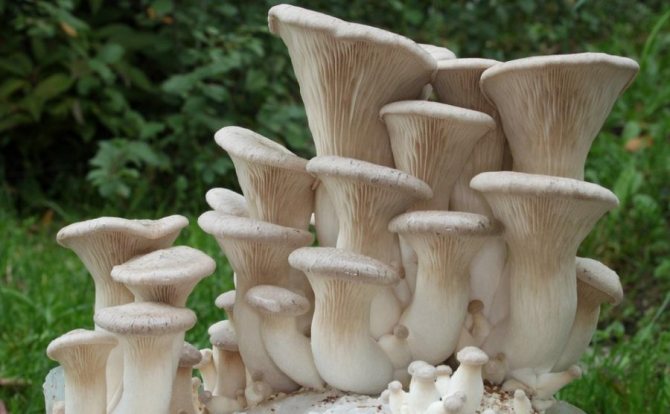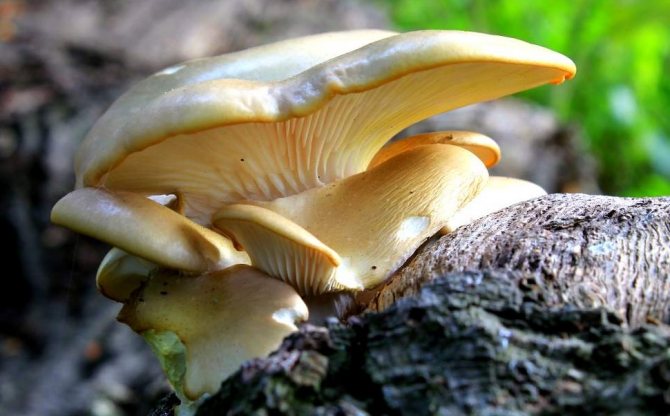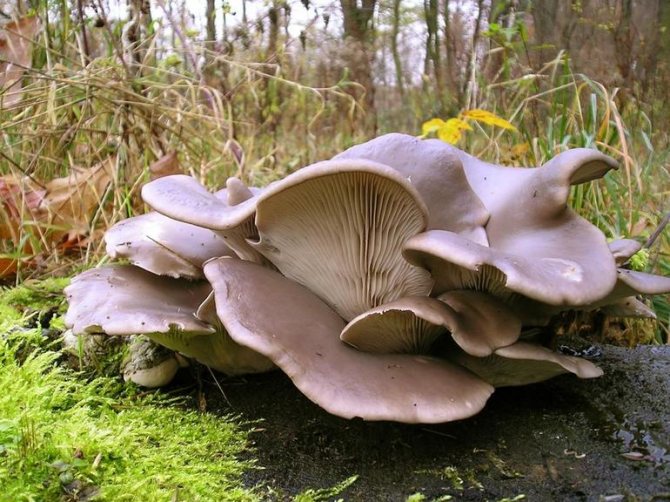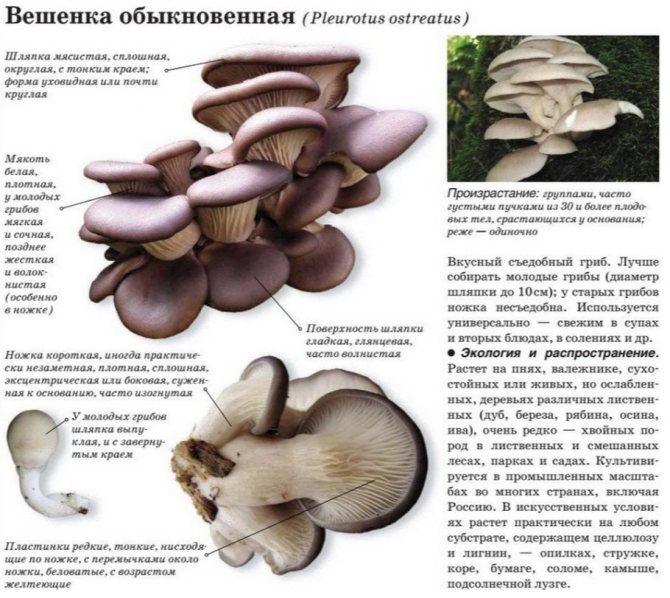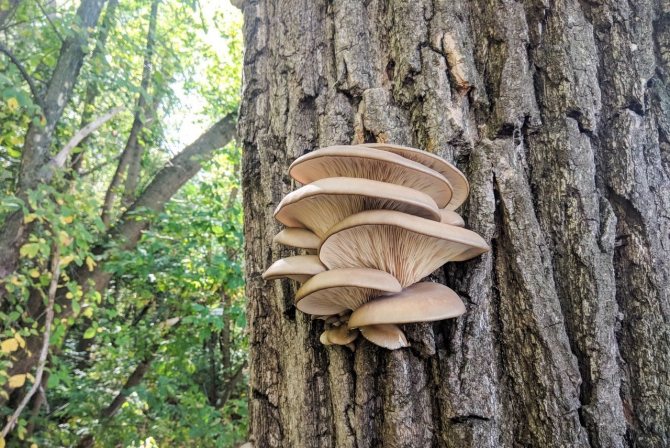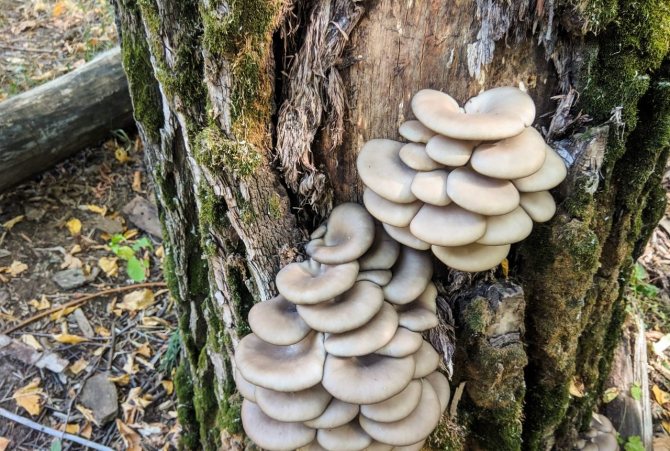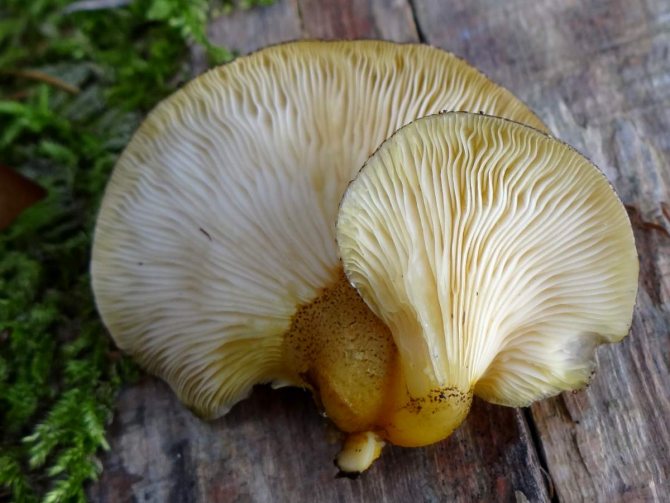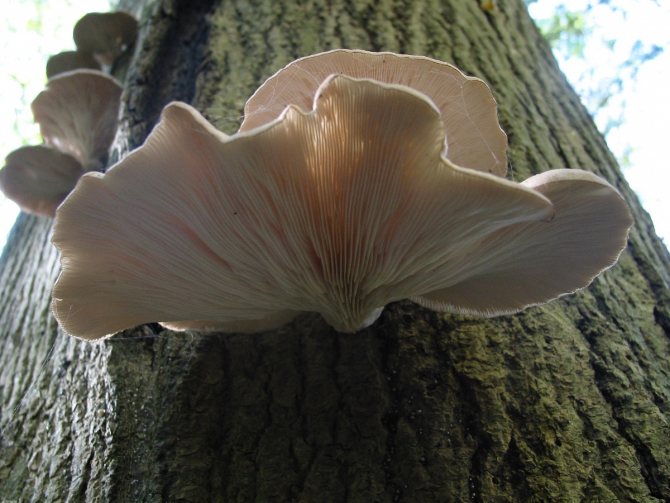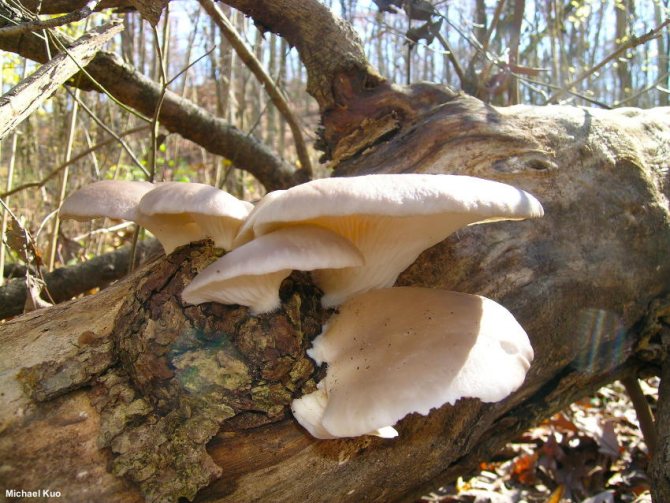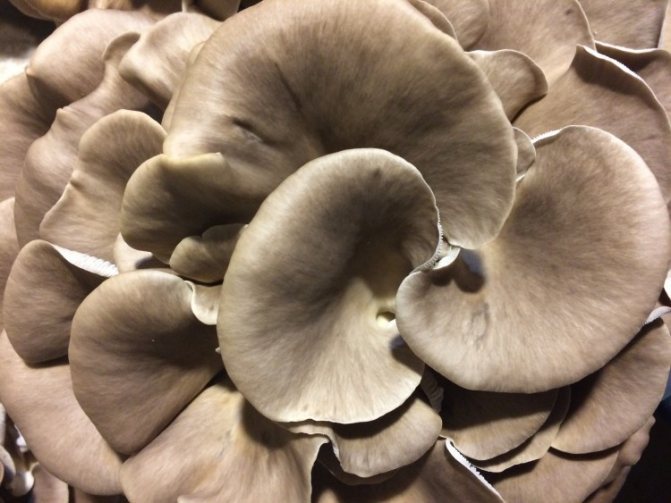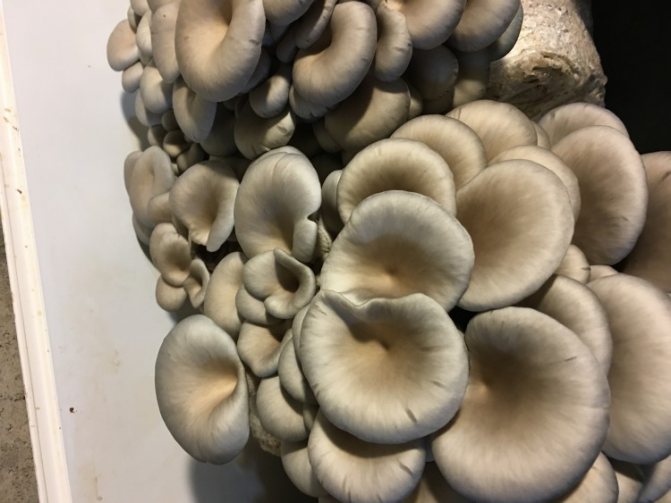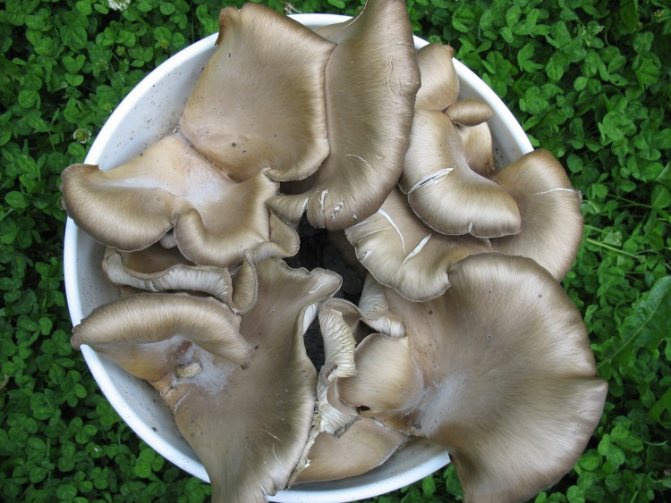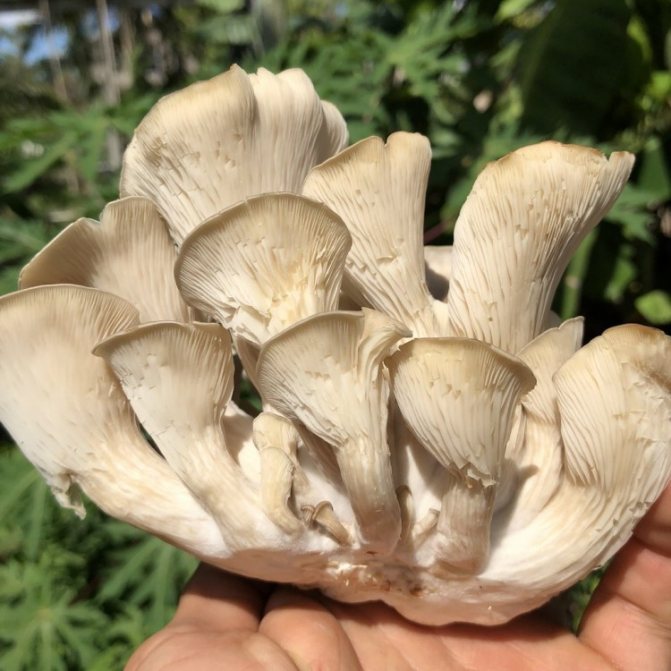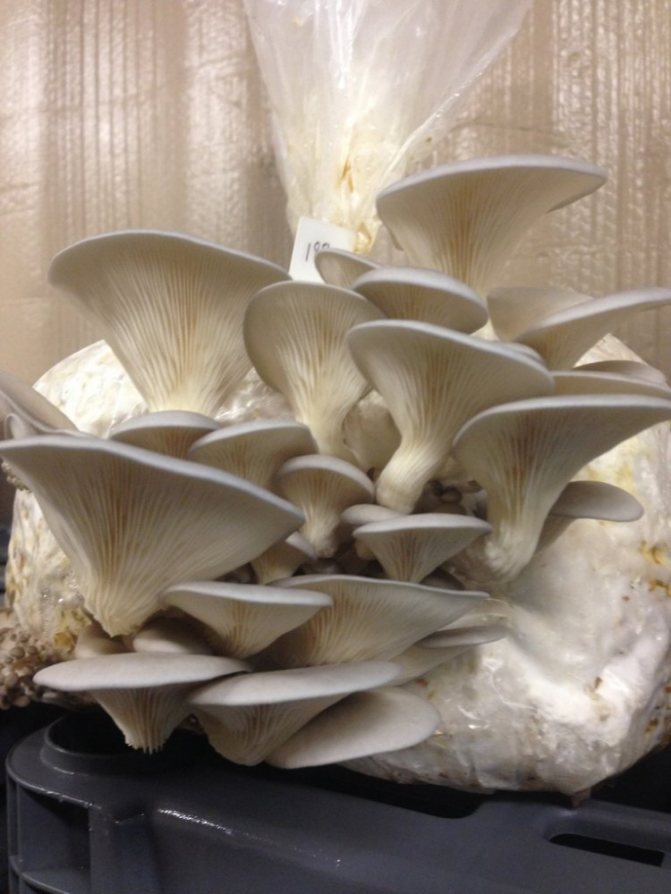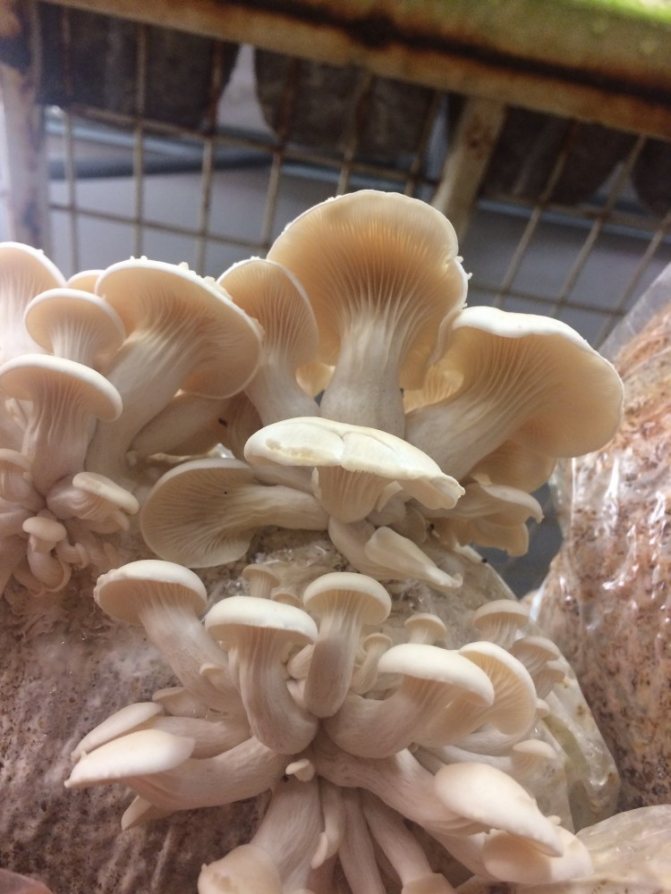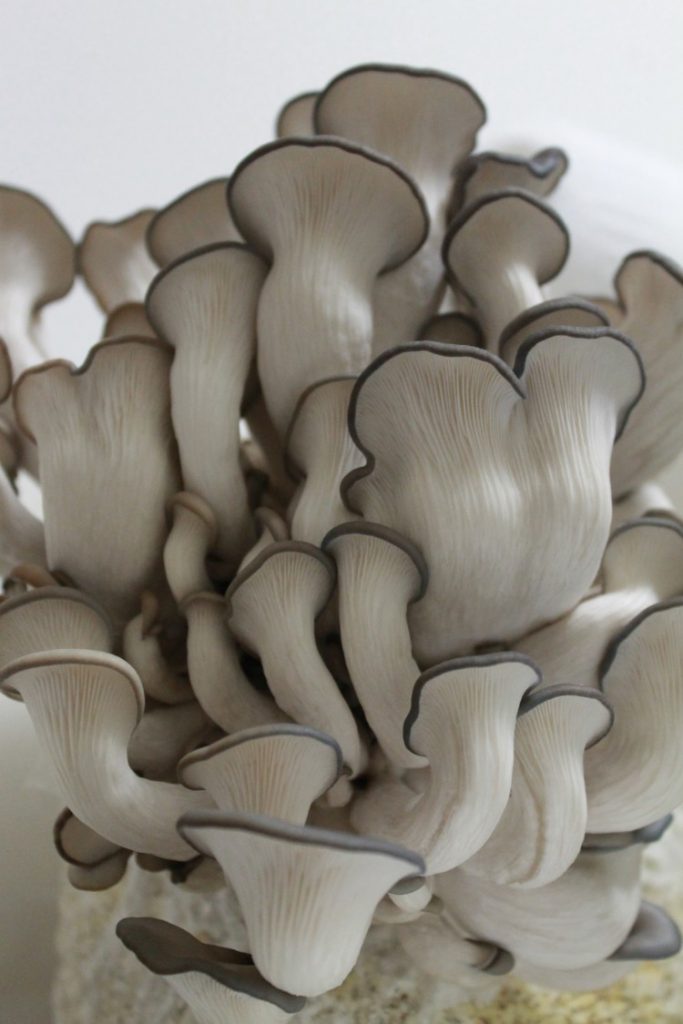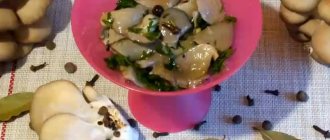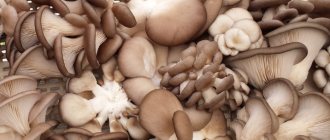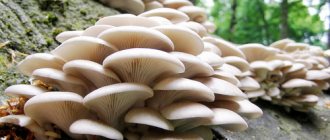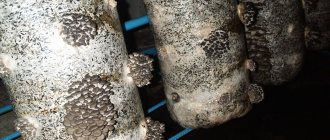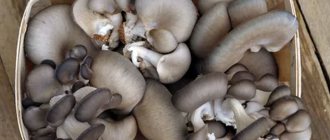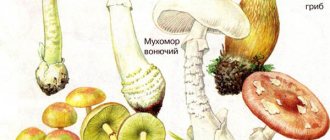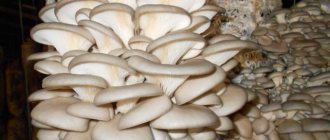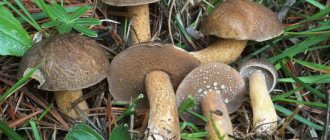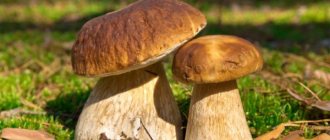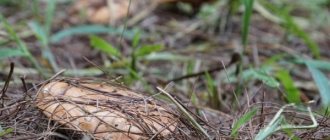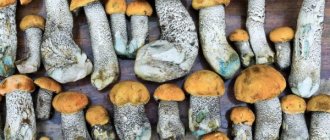Short description
| Mushroom type: | Conditionally edible |
| Other names (synonyms): | Late panelus, Late oyster mushroom, Alder oyster mushroom |
| Latin name: | Panellus serotinus |
| Family: | Mycene (Mycenaceae) |
| Distinctive feature: | Autumn oyster mushroom - a harbinger of the end of the mushroom season, begins to bear fruit in late autumn or winter, depending on the region. |
| Season start: | September |
| End of the season: | December |
| Leg height (cm): | 0.8-1.5 cm |
| Hat width (cm): | 3-10 cm |
| Smell: | absent |
| Taste: | insipid or bitter |
| Tasting score: | — |
| Hat: | semicircular, convex in youth, wavy at the edges, smooth, when wet, very sticky, then becomes sharp and sometimes striped. Light green, yellow, olive, brown or reddish olive. |
| Leg: | short, with small dots of dark ocher-colored scales on a saffron-yellow background, sometimes completely absent. |
| Hymenophore (lower part of the cap): | plates are creamy at first, and then creamy-ocher, wide at the edge, towards the stem, which become narrow, bifurcated, the edges are smooth. |
| Disputes: | cylindrical, allantoid, 4-6.6 x 1.2-1.5 microns. |
| Pulp: | watery, whitish, thick near the stem. With age, it becomes rubbery and tough. |
| Natural environment and mycorrhiza: | on the wood of various deciduous trees, sometimes on conifers. |
| False doubles: | differs from mushrooms similar to her in the non-leathery fleshy flesh of the cap. |
| Cultivation: | on an industrial scale, this mushroom is grown in Germany, Japan, Holland and France. |
| Use: | conditionally edible. The food can be eaten after preliminary boiling for 15 minutes or more. |
| Medicinal properties: | — |
| Spread: | widespread in Europe and North America. |
Lovers of quiet hunting, true connoisseurs of mushrooms, value oyster mushrooms not only for their taste. It is never attacked by worms and grows at a time when there are practically no other fungi. It is found in the forest in rather large groups.
Oyster mushrooms (mushrooms) - description, characteristics, photo
Oyster mushrooms are mushrooms in which the fruiting body consists of hats, smoothly turning into a leg. The hat is solid, slightly thinning towards the edges. Its shape is round or oval-elongated, resembling a shell. The diameter of the cap varies from 5 to 17 cm, although there are mushrooms in which the size of the cap reaches 30 cm. Young oyster mushrooms have a smooth glossy surface of the cap, slightly convex, with edges slightly tucked inward. However, as they age, they unfold, and the cap itself flattens.
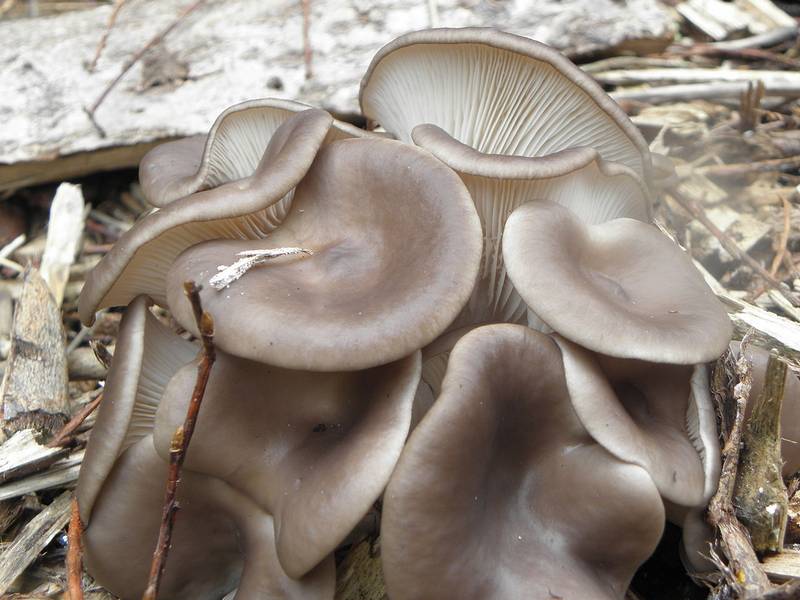
Photo Credit: Rob Hille, CC BY-SA 3.0
Depending on the species, coloration oyster mushrooms can be whitish, gray, brownish, lemon-yellow, brown-olive, ash-purple and even gray-lilac with shades of pink or orange.
Hymenophore with rather sparse and wide plates of whitish, yellow or gray color, deeply descending to the peduncle. White plates of a young mushroom turn gray or yellow with age.
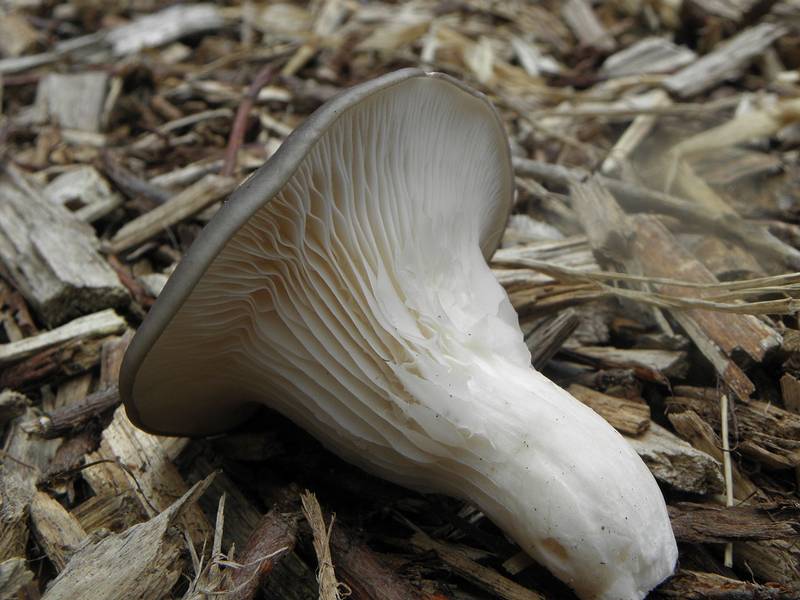

Photo Credit: Rob Hille, CC BY-SA 3.0
The tubular stem tapers towards the base, usually located eccentrically in relation to the cap. Its dimensions reach a maximum of 50 mm in length and 30 mm in thickness.
Legs of oyster mushrooms are white, yellowish or slightly grayish.


Photo by: Qwert1234, CC0
The fruit body of a young mushroom is firm and juicy. pulpwhich becomes fibrous, dry and tough as it ages.
Oyster mushroom spore powder has a white, cream or pinkish color, depending on the type of mushroom.
An effective way to grow oyster mushrooms on stumps
The planting of seed can be carried out in a more efficient way, introducing mycelium into previously made cuts 3-4 cm deep, 5-6 cm wide or drilled holes of the same depth and diameter 1.5-2 cm. After inoculation, the cuts are covered with fresh sawdust, and the holes - corks made of wood. The ends are covered with plastic wrap and sprinkled with a layer of earth.
Cultivation of oyster mushrooms on stumps lasts 3.5–4 months, then harvest time comes. Usually this period falls on the end of September, when daytime temperature fluctuations are 12-18 ° C, and nighttime - 3-7 ° C, which is considered the most optimal for oyster mushrooms. Before the beginning of fruiting, somewhere in the middle of September, the stumps get rid of the film and the earth layer. Please note that growing oyster mushrooms requires high humidity. Therefore, in dry weather, the ground around the stumps should be watered up to three times a week.
After 5–7 years, fully fertile stumps become rotten and crumble. Growing oyster mushrooms in this way can be used as a natural method for removing stumps in gardens, parks, dachas and home gardens.
To grow mycelium, you can also use pieces of 25-30 cm long, left over from cutting down trees (the diameter of the pieces is at least 15 cm). They are placed in a basement in a column of 3–6 blocks of wood on a mycelium (70–100 g) previously wiped with a damp clean cloth with a layer of 1–2 cm. , for example, burlap. When mycelium sprouts, carbon dioxide accumulates in excess in the basement, so drafts should be arranged for ventilation. In April, segments with sprouts of mycelium are planted in open ground.
Oyster mushroom species, photos and names
The division of oyster mushrooms into species was carried out in accordance with the species of trees on which these mushrooms developed, therefore the classification is rather arbitrary. Most scientific sources indicate that today there are several dozen species of these mushrooms in the oyster mushroom genus, which can be both edible and inedible. Among the most famous varieties of oyster mushrooms are:
- Oyster mushroom (oyster) (Pleurotus ostreatus)
Edible mushroom that also has names oyster mushroom or gliva... The size of the fleshy cap ranges from 5 to 15 cm, reaching 25 cm in diameter in some mushrooms. As the fungus ages, the slightly convex, rounded or oval-elongated cap becomes flatter, sometimes taking on a funnel-like shape. The color of the cap of the oyster mushroom is quite changeable and is light gray, slightly brownish or ashy with a slight purple tint. As it ages, it fades to a pale gray or slightly yellowish. The edges of the cap, bent inward, gradually straighten and become wavy or dissected-lobed. If common oyster mushrooms grow in high humidity conditions, mycelial plaque may form on the smooth, glossy surface of the cap. The leg of the common oyster mushroom is whitish, cylindrical, slightly curved and tapering towards the base of the mushroom, in relation to the cap it is located eccentrically, sometimes taking a lateral position. The length of the leg barely reaches 5 cm, and the diameter varies from 8 mm to 3 cm. Its smooth surface at the very base often becomes velvety-felt. The light plates of the hymenophore, located quite rarely, run low along the leg.As the fungus ages, their color changes to dirty gray or yellowish. The fruit body is firm and firm, although over time the flesh becomes tough and rather fibrous. The taste of young oyster mushrooms is pleasant, with a slight presence of aniseed notes. Under natural conditions, this type of oyster mushroom is widespread in countries with a temperate climate, where it grows in deciduous and mixed forests on rotten stumps or an accumulation of dead and fallen branches. The fungus is also found on the trunks of birch, oak, aspen, mountain ash or willow weakened by diseases. Most often, these mushrooms form massive clusters, from which multi-tiered bundles are formed - more than thirty fruit bodies can enter them. Mass collection of oyster oyster mushrooms begins in August-September and lasts until mid-November-early December. In some cases, due to favorable weather, the first fruiting bodies may appear as early as late May or early June.
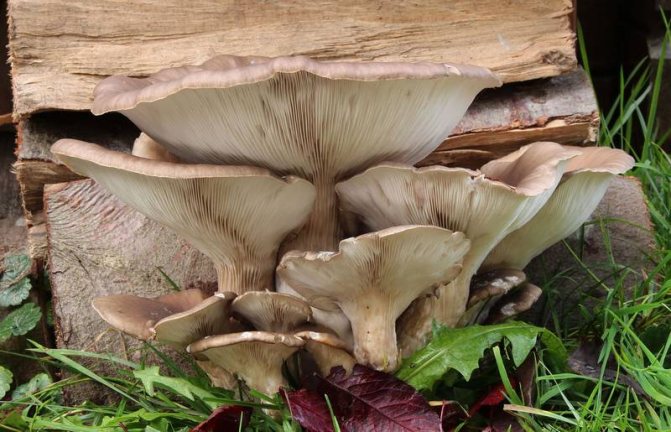

Photo Credit: H. Krisp, CC BY 3.0
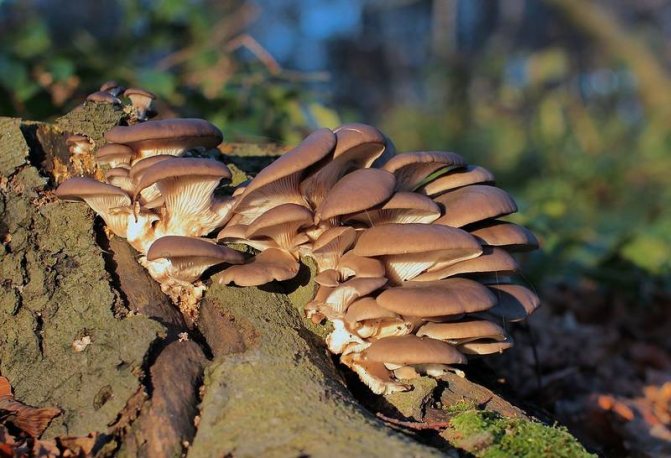

Photo by: Stu’s Images, CC BY-SA 3.0
- Oyster mushroom (plentiful oyster mushroom) (Pleurotus cornucopiae)
It is an edible mushroom shaped like a shepherd's horn. The cap of the mushroom is horn-shaped or funnel-shaped, sometimes acquiring a lingual or leaf-like shape. The size of the fleshy and smooth cap ranges from 3 to 12 cm in diameter. In young mushrooms, its edges are bent down, but as they age, they level out, bend up and often crack. The color of the horn-shaped oyster mushroom depends on the conditions, place of growth and age and varies from light sandy to gray with ocher shades. The consistency of the pulp in the cap also changes with aging: over time, from dense and elastic, it becomes tough, with pronounced fibers. Unlike other types of oyster mushrooms, the horn-shaped oyster mushroom has a well-developed rather curved leg, the length of which can reach 8 cm with a thickness of no more than 2 cm. as a result, a kind of pattern is formed. The leg is attached to the cap from the side. The oyster mushroom grows in abundant groups, mainly on the stumps and deadwood of an elm, although in very rare cases it is found on wood of other deciduous species. The growing area includes almost the entire territory of Russia and the North Caucasus. There are populations of oyster mushrooms in China, as well as on the islands of Japan. The period of abundant fruiting begins in the first decade of May and ends in mid-September.
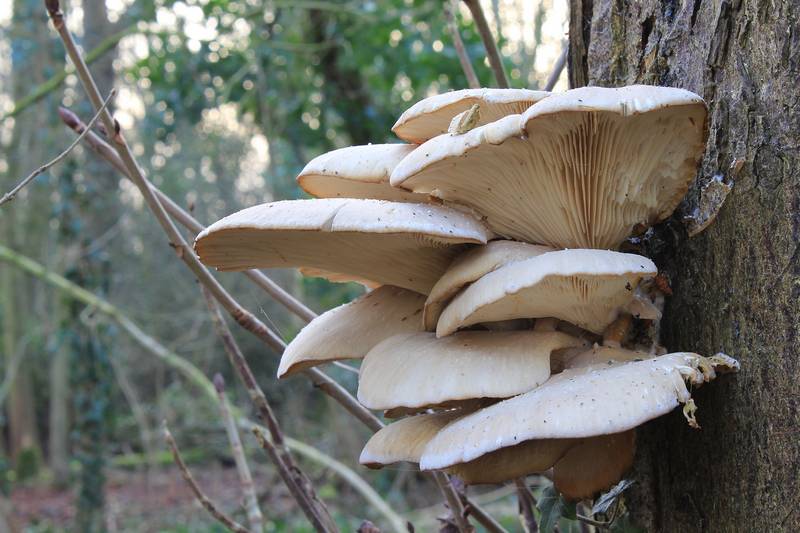

Photo by: Stu’s Images, CC BY-SA 3.0
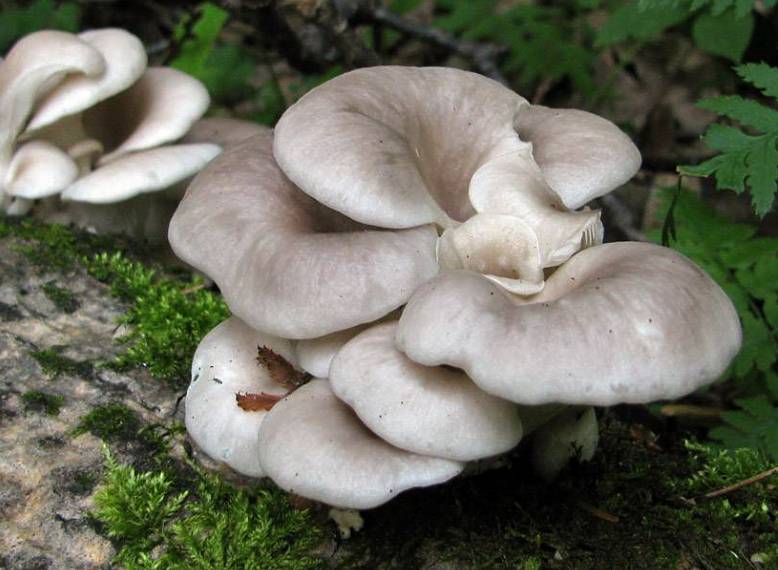

Photo by: Ak ccm, CC BY-SA 3.0
- Covered oyster mushroom (sheathed oyster mushroom) (Pleurotus calyptratus)
An inedible mushroom due to its tough rubbery pulp. The species got its name because of the film that covers the plates of the hymenophore in young mushrooms, however, with aging, such a peculiar veil breaks, and its remnants can be observed along the edge of the cap. In young oyster mushrooms of this species, the cap resembles a large bud, however, as the fungus grows, it covers the tree trunk and takes the form of an open fan with a convex surface and edges tucked down. The surface of the cap is smooth and slightly sticky with noticeable wet stripes radiating outward from the trunk. The fruit body is gray-brown or flesh-brown, which in dry weather takes on a gray-steel hue. With aging, the color of the cap fades, it becomes whitish or almost white. The leg is practically absent. The plates of the hymenophore of the covered oyster mushroom have a yellowish-cream color. The whitish flesh of the fruiting body, which smells like cut raw potatoes, has a dense rubbery consistency. The first single-growing oyster mushrooms of this species appear at the end of April on fallen or dried aspens in the mixed and deciduous forests of Denmark, Latvia, Sweden, Ireland, Austria, Germany, Switzerland and other countries of Central and Northern Europe. The fruiting period ends at the end of June.
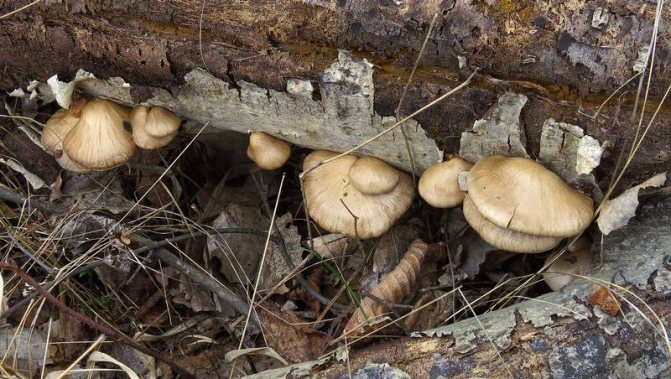

Photo by: Aimaina hikari, CC0
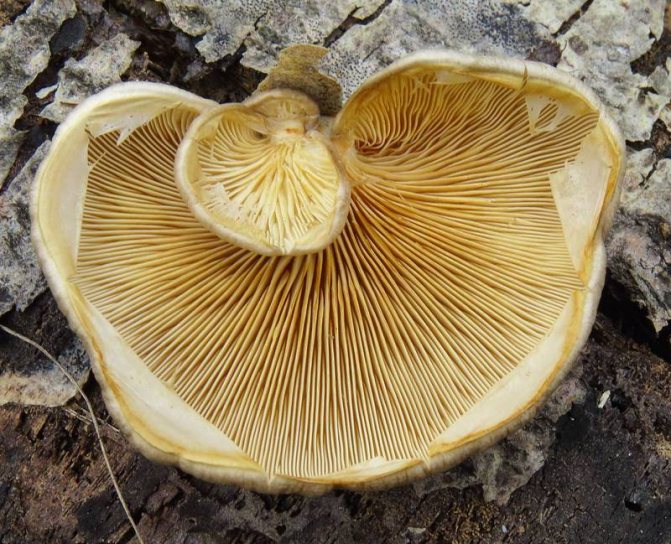

Photo by: Aimaina hikari, CC0
- Oak oyster mushroom (dry oyster mushroom, oak pleurotus) (Pleurotus dryinus)
Refers to edible mushrooms. The dimensions of a fleshy semicircular, elliptical or tongue-shaped cap range from 4 to 10 cm.In young oak oyster mushrooms, its surface, painted in yellowish or cream colors, is covered with scales, slightly convex, but as the fungus grows, it becomes flatter and even concave. The edges of the cap are wavy, and in old mushrooms they are sometimes dissected by shallow cracks and remnants of the veil protecting the hymenophore. A velvety leg with remnants of a membranous ring 4 to 10 cm long, has a cylindrical shape, sometimes thickening towards the base. In relation to the cap, the leg of the oak oyster mushroom can be located in the center or take a lateral position. Quite frequent plates of the hymenophore run down the pedicle almost to its base. Their color changes with age and ranges from white to cream or off-yellow. The dense, slightly harsh pulp of the fruiting body has a rather pleasant sweetish aroma. Oak mushroom grows in many European countries with a temperate climate, as well as in North America, preferring the trunks of broad-leaved trees (oak, elm), although it can also bear fruit on the remains of other species. Usually grows singly, only occasionally forming small clusters. Collecting oak oyster mushrooms begins in the second half of July and ends in early September.


Photo Credit: H. Krisp, CC BY 3.0
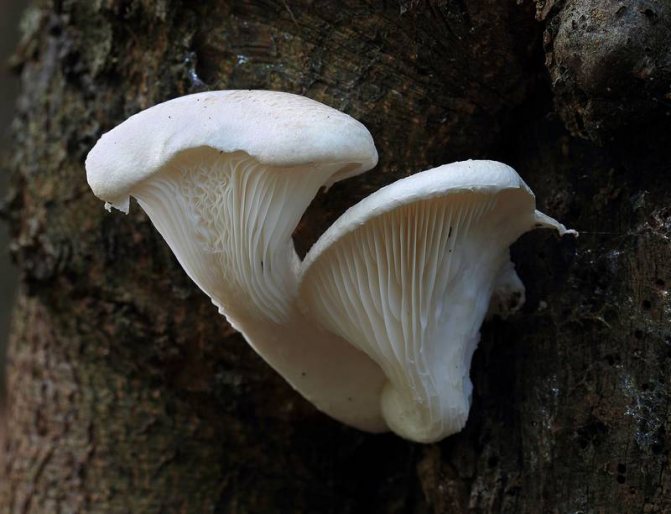

Photo by: Stu’s Images, CC BY-SA 4.0
- Oyster mushroom (Pleurotus eryngii), she yeringi, white steppe mushroom, royal oyster mushroom
Belongs to the category of valuable edible mushrooms. The round or oval cap of young oyster mushrooms of this species is slightly convex, but with aging it acquires a flat or slightly funnel-shaped shape. The surface of the cap is covered with small scales or fibers and is colored red-brown. The size of the cap varies from 4.5 to 13 cm. The skin color changes over time to brown or pale ocher. The height of the cylindrical white or brownish-buffy stem ranges from 2 to 5 cm, and its diameter in the thickening near the base can reach 2.5 cm. In relation to the cap, the stem of the steppe oyster mushroom is located in the center, less often a little on the side. The hymenophore is of the lamellar type with often spaced pinkish-creamy plates that run down to half of the stem. The pulp of this type of oyster mushroom is white, sometimes with a slight brown or pink tint. Oyster mushroom is common in Germany, Poland, Czech Republic, Slovakia, France, Spain, Italy, Greece, Turkey, Cyprus, Egypt, Algeria, India, the foothills of the Tien Shan and Pamir ridge, as well as in other countries of Western Asia and Central Europe. These steppe mushrooms are also found on the territory of Russia (up to the Primorsky Territory) in the steppes of Central Asia. It is noteworthy that oyster mushrooms of this species form mycorrhiza with the roots of numerous umbrella plants, and do not use the trunks of dead trees as a substrate. Royal oyster mushroom bears fruit only in the spring months.


Photo by: H. Krisp, CC BY-SA 3.0


Photo by: LOBO QUIRCE, CC BY-SA 4.0
- Oyster mushroom (Pleurotus pulmonarius), she whitish oyster mushroom, spring oyster mushroom or beech oyster mushroom
It is the most commonly found edible member of the genus in vivo. The sizes of a rounded, tongue-shaped or fan-shaped cap with elastic flesh range from 4-8 cm, although in some specimens it can reach 15 cm. Its slightly cracked edges are tucked down and are much less thick than the central part. The color of the cap of the pulmonary oyster mushroom is white or cream, acquires a yellow tint with age. A white or grayish leg, covered at the base with a fine nap, is rather short (up to 20 mm high), although there were pulmonary oyster mushrooms, in which it measured about 40 mm. Rarely located white plates of the hymenophore run along the eccentrically located pedicle almost to its base. The oyster mushroom begins to bear fruit abundantly on the fallen decaying trunks of deciduous trees in May and ends at the end of September. Spring oyster mushrooms are rarely found singly, mostly they form rather large clusters that grow together with their legs.


Photo Credit: Jörg Hempel, CC BY-SA 2.5
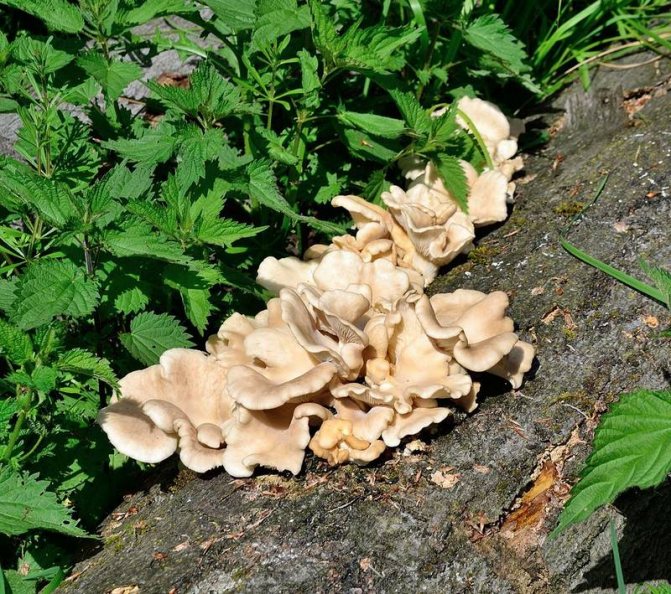

Photo by: Tsungam, CC BY-SA 3.0
- Pink oyster mushroom (Pleurotus djamor), or oyster mushroom flamingo
Belongs to the class of edible mushrooms. Weakly convex caps of young oyster mushrooms of this species are painted in a rich pink or grayish-pink color. As the fungus ages, the lingual or rounded cap, reaching 3-5 cm in size, becomes flat with thinned and cracked edges, and its color is paler with small yellow spots. Oyster mushroom pulp is light pink in color, with an oily taste and original aroma. Whitish-pink, short, curved leg, no more than 2 cm long, connects to the side of the cap. The reddish-pink plates of the hymenophore, which run low on the stem, brighten over time. The distribution area of pink oyster mushroom includes Thailand, Malaysia, Singapore, Vietnam, Mexico, Brazil, Western India, Japan, Australia and New Zealand, as well as other countries of the subtropical and tropical zones. On the territory of the Russian Federation, pink oyster mushroom grows in the forests of the Far East and Primorye.


Photo Credit: H. Krisp, CC BY 3.0
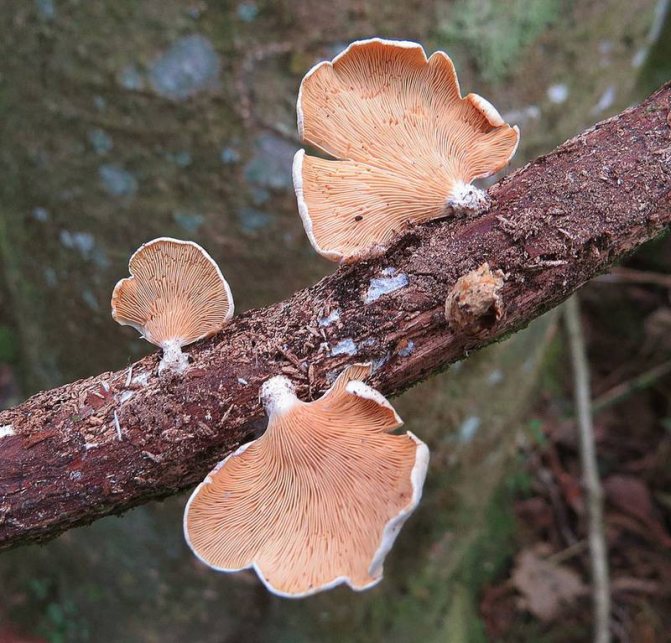

Photo Credit: Dick Culbert, CC BY 2.0
- Lemon-hat oyster mushroom (Pleurotus citrinopileatus), ilmak or golden oyster mushroom
Quite rare edible mushroom with a pleasant taste and original aroma. The average size of the caps ranges from 3-6 cm, although in some specimens it can reach 10 cm. In young oyster mushrooms, the cap has a corymbose shape, which, as it grows, gradually acquires funnel-shaped outlines with refined edges resembling dissected lobes. Its lemon-yellow color fades with age and becomes whitish, sometimes completely white. In young elmaks, a rather long cream-colored leg, up to 6-9 cm high, is located in the center of the cap, but as it ages, the cap of the oyster mushroom shifts to the side and takes an eccentric position. Lemon-cap oyster mushroom grows in the North American continent and in Asia. On the territory of Russia, oyster mushroom is found in deciduous and mixed forests of Eastern Siberia, the Far East and Primorsky Territory. It grows in large groups on dry branches and on the remains of elm trunks. The number of mushrooms that make up the group can reach eighty pieces. Abundant fruiting of oyster mushrooms lasts from early May to October.


Photo by: Chatama, CC0
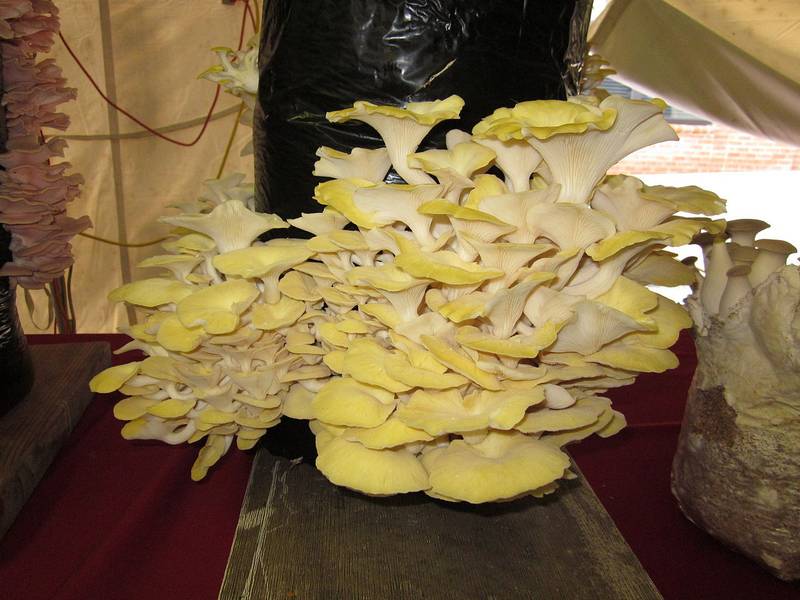

Photo by: PookieFugglestein, CC0
Difference from doubles
Going for mushrooms, you need to remember one thing - there are no poisonous counterparts of oyster mushrooms on the territory of Eurasia. The only poisonous twin grows far from us - in Australia, and is called Omphalotus nidiformis.
However, there are false mushrooms. The false representative has brighter colors and shades than the real one. The two most popular species are orange oyster mushroom and wolf saw-leaf. They are not poisonous, but they are completely unsuitable for eating, since they have an unpleasant odor and are very bitter.
The false orange oyster mushroom is colored bright orange. There are practically no legs, and it clings to the tree trunks with a spreading hat. At a young age, it smells like a melon, while an adult mushroom smells like rotten cabbage.
The pulp is dense, the surface is fluffy. It is located on the bark of trees in a fan-like bunch. Because of the external beauty, some gardeners purchase the spores of these mushrooms from flower shops and decorate their gardens and landscapes with them.
Felted saw-leaf, or wolf, is also inedible. It grows on dead wood of both conifers and deciduous plants. It is most often found in nature from summer to mid-autumn. The hat is brown or cream, similar in shape to the tongue of a dog. There are almost no legs at all. The pulp is bitter, with an unpleasant, pungent odor.
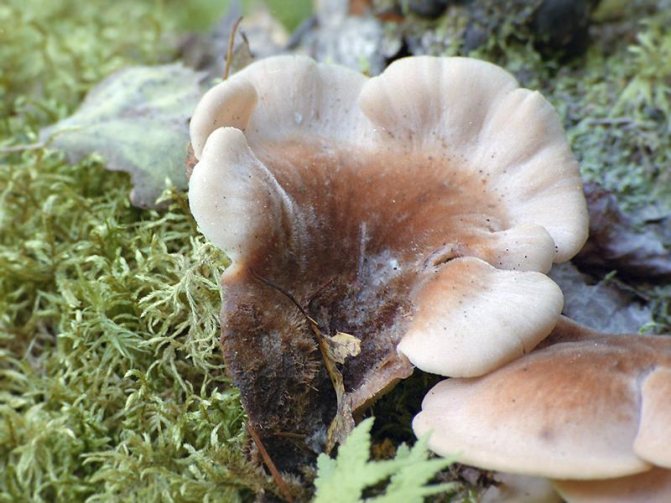

Going to the forest for an oyster mushroom, it should be remembered that mushrooms similar to oyster mushrooms do not grow on the ground, they are found on the trunks of living and dead plants, as well as their stumps.
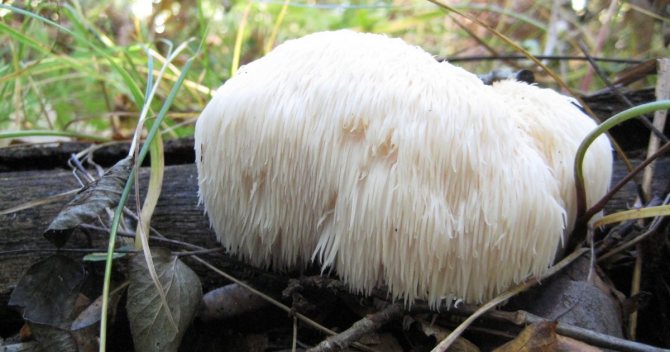

You may be interested in:
What does a blackberry mushroom look like and its description (20 photos) A rare edible mushroom called "blackberry" differs sharply from others, has an unusual structure, special taste and ... Read more ...
Where and how do oyster mushrooms grow?
Under natural conditions, oyster mushrooms grow on organic remains of shrubs and deciduous trees (stumps, dead wood or fallen trunks, logging waste). Most often, aspen, linden, oak or alder wood can act as a substrate. Mushroom aggregates can be seen on poplar and birch, hornbeam or chestnut, as well as on some conifers. Almost all types of oyster mushrooms form large groups, which can include up to 30 or more fruiting bodies, and the mass of such a "cluster" can reach 3 kilograms. On the trunks, the aggregates are located one below the other or grow side by side without any system. There are also some species that grow among the roots of umbrella plants.
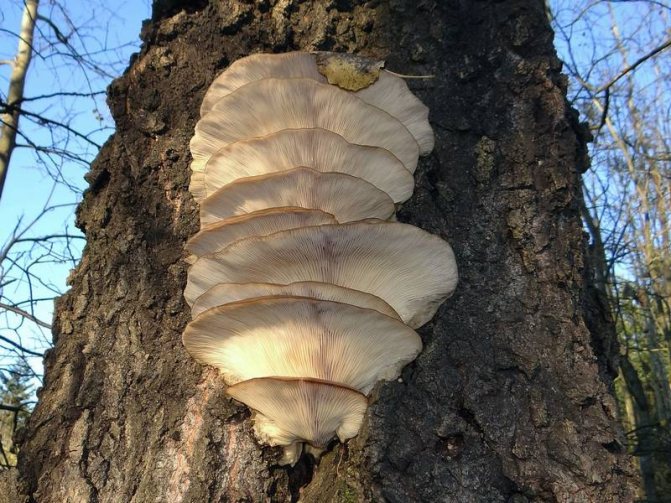

Photo by: Jerzy Opioła, CC BY-SA 4.0
The distribution area of the Pleurotus genus includes North America, Germany, Portugal, Denmark, Slovakia, France, Poland, as well as other European countries, North African countries (Sudan and Egypt), Asian countries (Pakistan, India, Malaysia) and Australia.
On the territory of Russia, oyster mushroom grows everywhere, starting from the borders with Belarus, ending with Eastern Siberia and the Primorsky Territory.


Photo by: Richenza, CC BY-SA 3.0
Room for growing oyster mushrooms
An old barn, a stone garage or a former pigsty can serve as a room for growing oyster mushrooms. The most important criterion when choosing a room for sowing oyster mushroom mycelium should be the ability to maintain high air humidity (85–90%) and maintain the temperature from 15 to 20 degrees, as well as the presence of a good ventilation system and competent lighting.
Oyster mushrooms do not like high temperatures; at temperatures above 25 degrees, they will not bear fruit. Therefore, the use of greenhouses as a room for sowing oyster mushroom mycelium is unacceptable.
Mushrooms are sensitive to carbon dioxide. It is best to plant oyster mushroom mycelium at a low level. Therefore, good ventilation in the room is the key to success.
The chambers where the seedlings are located should be illuminated. It is better if it is natural light, but it is advisable to avoid direct sunlight on myceliums. In the absence of windows in the room, fluorescent lamps are used for growing oyster mushrooms. Constant lighting is not necessary, 8-9 hours a day is enough.
At what temperature do oyster mushrooms grow?
Artificially cultivated species of oyster mushrooms (strains) are subdivided according to the ripening time of the fruit bodies.
- For example, the winter oyster mushroom is bred from frost-resistant species that can bear fruit at an air temperature of 4 ° C to 15 ° C. Mushroom caps of this type can be gray, blue or dark brown.
- Summer oyster mushroom strains were brought to Russia from Florida. Fruiting of this group of oyster mushrooms occurs at temperatures from 15 ° C to 25 ° C. At a higher air temperature, the growth of fruits stops for a while and resumes with a decrease. Summer oyster mushroom has a very delicate and fragile fruit body.
- Year-round fungal strains were obtained from the pulmonary oyster mushroom (Pleurotus pulmonarius). They bear fruit in a temperature range of 6 ° C to 28 ° C. The color of the cap of year-round oyster mushrooms varies in a wide range of gray and can be either light or dark.
Beneficial features
Oyster mushrooms are excellent edible mushrooms, rich in vitamins and minerals, with high nutritional value and excellent taste. Fruit bodies are characterized by low calorie content and at the same time they contain all the substances necessary for the vital activity of the body.
The protein composition is extremely valuable, essential amino acids are found in the pulp, including valine, lysine, leucine, threonine, phenylalanine, methionine.Proteins are easily digested and the nutritional value of hearty oyster mushroom dishes is close to meat and dairy products.
The compound found in the pulp is lovastatin, which lowers cholesterol levels, prevents plaque formation and the development of atherosclerosis.
The complex of polysaccharides, secreted from the tissues of fungi, inhibits the growth of tumors, has an immunomodulatory effect. Fiber elements are able to absorb toxic substances, playing the role of natural sorbents.
The vitamin composition surpasses many vegetables and fruits, in addition, there are fat-soluble vitamins, which are found only in meat and dairy products. In terms of vitamin C and PP content, oyster mushrooms surpass vegetables by 6-10 times, and besides, they contain all the vitamins of the B group, which are responsible for the functioning of the hematopoietic organs, the nervous system, and the healthy state of the skin.
Oyster mushrooms - benefits and harms
Beneficial features
Due to the fact that most of the oyster mushrooms on sale today are grown on an environmentally friendly substrate of plant origin, their fruiting bodies do not accumulate heavy metals and toxic substances. In addition, many gourmets admit that oyster mushrooms are somewhat superior in taste to champignons, and when skillfully cooked, they taste like porcini mushrooms.
Eating oyster mushrooms is possible only after heat treatment of the pulp. Oyster mushrooms are used for frying and stewing, making sauces and soups, pickling and pickling. In addition, it should be remembered that these mushrooms, meat of birds and animals can complement each other, but they do not go well with fish.
The oyster mushroom pulp contains a full set of nutrients that are necessary for the normal functioning of the human body:
- Vitamins: B, C, E, D2 and PP,
- Minerals: iron, calcium, potassium, iodine,
- Amino acids: leucine, threonine, phenylalanine, valine.
Fats contained in the body of the mushroom in small quantities belong to the group of polyunsaturated fatty acids, which significantly reduce blood cholesterol levels.
The carbohydrates in the oyster mushroom pulp are almost 20% sucrose, fructose and glucose, which are easily absorbed by the body and do not lead to fat deposition. Oyster mushroom polysaccharides are a powerful immunomodulatory agent with an antitumor effect.


Photo by: Archenzo, CC BY-SA 3.0
Alcohol extracts and extracts prepared from the pulp of these mushrooms allow effective prevention of:
- thrombophlebitis,
- hypertension,
- atherosclerosis,
- obesity.
In addition, oyster mushrooms are able to remove various toxins and radioactive isotopes from the body. Due to their low calorie content, the presence of a large number of dietary fiber and fiber, mushrooms are actively used in dietetics to fight obesity.
Harm and contraindications
It should be remembered that in the pulp of oyster mushrooms there is a special substance, chitin, which the human body practically does not assimilate. To destroy the structure of this substance, the pulp of the mushroom is finely cut and subjected to heat treatment.
- Unfortunately, it is impossible to completely get rid of chitin, so doctors do not recommend giving oyster mushrooms to children under the age of five.
- For adolescents, mushrooms should be eaten with great care and in small quantities.
- The same recommendations can be applied to elderly people, as well as for those who have problems with the gastrointestinal tract, liver, pancreas or kidneys.
- With all the positive characteristics of these mushrooms, care must be taken during their collection and preparation, especially for allergy sufferers: spores that enter the human body by inhalation can cause an allergic reaction.
- For oyster mushrooms to be beneficial, they need to be eaten no more than 2 times a week.
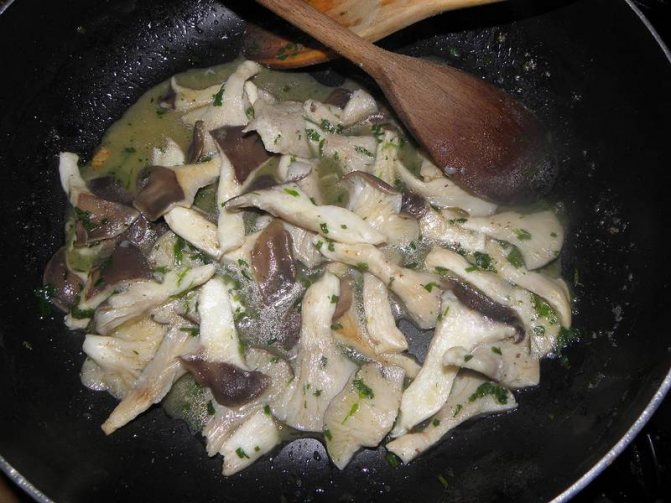

Photo Credit: Rob Hille, CC BY-SA 3.0
Nutritional value
According to their nutritional value, oyster mushrooms can be divided into four categories.Usually all representatives of this family are edible, but there is a false mushroom and here you need not to confuse their description and avoid mistakes when collecting. Only five of the nine varieties are considered the best for eating, since the rest of the pegs have a tough and fibrous pulp.
A 100-gram serving of raw mushrooms has been proven to contain:
| Squirrel | 3.31 grams |
| Fats | 0.41 grams |
| Carbohydrates | 4.17 grams |
| Alimentary fiber | 2.3 grams |
| Ash | 1.01 grams |
| Water | 9 grams |
It is known that 100 grams of such a product contains approximately 34 kcal. Besides, it contains vitamins and macro- and microelements:
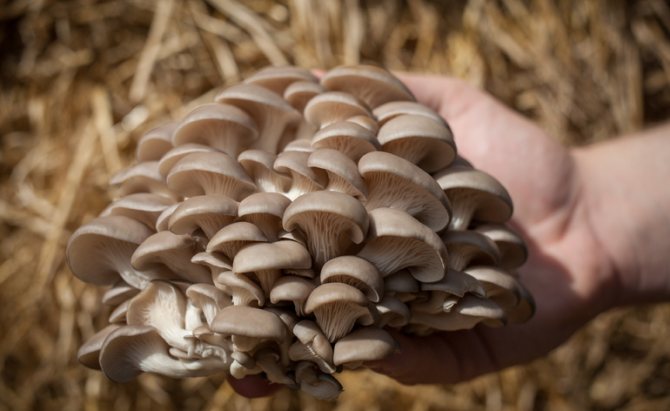

- Vitamins B.
- PP vitamins.
- Vitamins C.
- Vitamins D.
- Phosphorus.
- Iron.
- Copper.
- Selenium.
- Potassium.
- Zinc.
Such a rich composition of this mushroom plant allows it to be used to treat many diseases. It is known that these representatives of the mushroom kingdom are completely safe, since they do not accumulate toxins in themselves. But still, like any mushrooms, they are considered heavy food.
Oyster mushrooms in the forest. How they grow. How to recognize.
Growing oyster mushrooms at home and not only
Oyster mushrooms are quite easy to grow not only on an industrial scale, but also at home, while collecting high yields. If you follow the recommendations and growing technology correctly, you can get about 3 kg of oyster mushrooms from 1 kg of mushroom mycelium. By assimilating lignin and cellulose from the substrate, they are able to multiply on any basis, which includes various plant residues.
Mushroom growers have developed 2 methods for breeding these mushrooms:
- intensive (growing in artificial conditions),
- extensive (growing in a natural environment).
How to store oyster mushroom mycelium correctly?
- At temperatures from -2 to 0 degrees - 30 days
- At temperatures from 0 to +2 degrees - 14 days
- At temperatures from +15 to +18 degrees - 3 days
- At temperatures from +20 to +24 degrees - 1 day
Intensive way to grow oyster mushrooms on bags
Positive sides
- there is a large selection of raw materials that are used as a substrate for growing oyster mushrooms. These are agricultural waste: cereal straw, sunflower husk (husk), corn stalks and cobs, reeds, sawdust of deciduous trees, etc.;
- the compost fouling rate is quite high;
- mushrooms are more resistant to disease;
- the ability to harvest at any time of the year;
- the spent substrate can be used in the garden as an organic fertilizer or added to feed for poultry and animals.
Negative sides
For intensive cultivation, capital investments and premises are needed, in which a special microclimate is maintained for the planting and growth of myceliums.
Growing room
It is possible to breed oyster mushrooms in an intensive way in any non-residential premises, in the basement of a house, on a glazed balcony or loggia. To obtain a positive result, the following condition must be fulfilled: to prevent infection of the mycelium, the room where the oyster mushroom mycelium is planted and the room in which the mushrooms grow must be separate. All work with mycelium should be carried out only with gloves.
Oyster mushroom growing technology
- The first step is to prepare the base on which the mycelium will grow. To do this, you need to take 25 liters (or 2.5 buckets) of clean, fresh substrate that does not contain any foreign impurities. Oyster mushrooms are very fond of moisture, so they moisturize the substrate. To do this, it can be treated with hot water or hydrothermal treatment. This method is often used for growing oyster mushrooms at home. The raw material is placed in a container (pan, tank) and filled with water, which must completely cover the material. Boiling lasts no more than 1.5 hours.Raw materials in containers can be immediately put into plastic bags (bags), having previously made small holes in them for free circulation of water. Then the water is drained. The main thing is not to overmoisten the substrate so that mold and rot do not appear. In case of excess moisture, the material is placed under pressure for a while so that the excess water is glass. The moisture content of the substrate should not exceed 30%. The substrate should cool down to 25 ° C. Then it is crushed into small pieces that can retain moisture. A properly prepared and moistened substrate should be air-permeable, springy when squeezed by hand, while water should not protrude outside. You can also saturate a dry or moist base with moisture by steaming it over low heat for half an hour.
Often, supplements are added to the substrate, which allow the mushrooms to grow faster and increase the yield by 30%. A growth activator in the form of a powder can be added at the stage of processing the substrate, liquid supplements can be added to the substrate before sowing the mycelium.
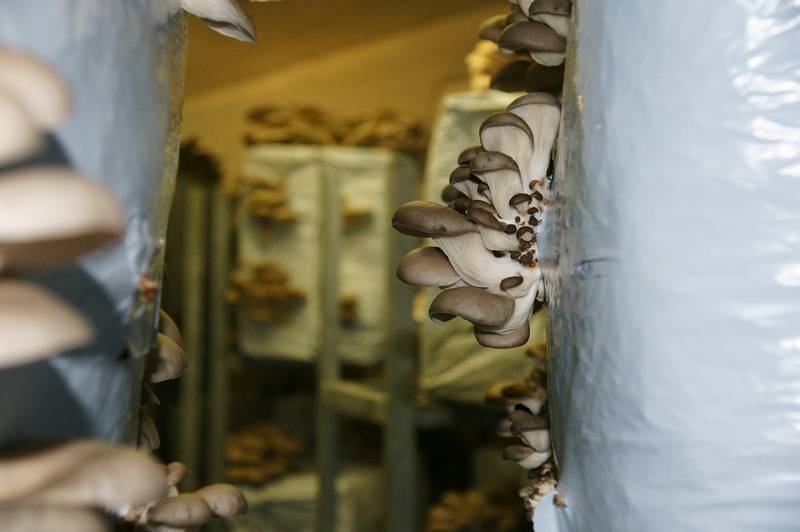

Photo Credit: Nienetwiler, CC BY 2.5 ch
- The second stage involves the inoculation process. The raw materials are taken to a room that has been previously disinfected with a 1% solution of bleach. In order not to infect the mycelium, in the room where the mycelium is laid in the substrate, all doors are tightly closed and the ventilation system is turned off. With a mixture of the mycelium of oyster mushrooms and the base, they tightly fill bags pre-treated with alcohol or polyethylene sleeves, designed for 5-15 kg. You can buy for these purposes plastic bags with dimensions of 350x750mm or 350x800mm. According to some guidelines, you do not need to treat bags with alcohol. Small holes are pierced at the bottom of such blocks to drain excess moisture. On the sides of these blocks, incisions are made 50 mm long and at an angle of 45 ° so that there are more fruiting bodies.
- The third stage is the incubation period, which lasts from 2.5 to 3.5 weeks. Blocks with the mixture are placed vertically on racks or shelves so that there is little space between them (about 50 mm). Their sides with slots should also not touch the walls for free air circulation. Mushroom bags cannot be stacked on top of each other. The room in which the incubation period of oyster mushrooms takes place should not be ventilated. This contributes to a high concentration of carbon dioxide and increases the humidity in the room. It must maintain a constant temperature of no higher than 25 ° C, otherwise there will be much less mushroom seedlings. During this period, oyster mushrooms do not need lighting either. But every day in the room you should do wet cleaning using solutions containing chlorine.
- The fruiting stage has several waves. The first lasts approximately 45 days. At this time, the bags are carefully transferred to a bright room, since now the oyster mushrooms need more air, light and humidity (about 85-95%). To keep it within such limits, the blocks are covered with wet gauze, and as it dries, they are moistened. A couple of times a day, you can spray water over the mushroom caps from top to bottom. The color of the cap depends on its temperature. The cooler the water (from 10 ° C), the darker the color. When watering with water at a temperature of about 20 ° C, the color of the caps will be lighter. The room at this stage must be well ventilated. The first harvest is the largest - from one bag you can get from 3 to 6 kg of mushrooms. 14-21 days after this, the second fruiting period begins. If you take care of the oyster mushrooms properly, you can harvest them within six months.
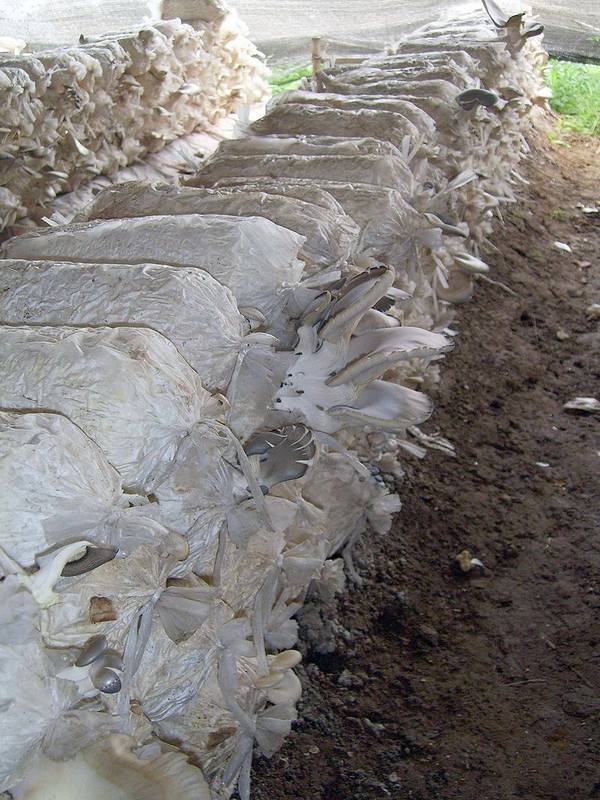

Photo Credit: Shizhao, CC BY 2.5
Extensive way of growing oyster mushrooms on stumps
Positive sides
- you can use heavily shaded areas of agricultural land or vegetable garden;
- the raw material for the base is usually wood processing waste. For growing oyster mushrooms, you can take sawdust, tree bark, shavings, hemp and even paper;
- there is no need to monitor the process during the incubation period;
- in one place, the crop can be harvested for 4-7 years.
Negative sides
With extensive cultivation, the yield depends on the season and the vagaries of the weather.
Substrate for growing oyster mushrooms
For the extensive cultivation of oyster mushrooms, the remains of deciduous trees are well suited. It is undesirable to use coniferous sawdust or logs. Cherry, apple, walnut, oak and alder stumps for growing these mushrooms are considered the best material. Oyster mushrooms can be grown on them not only in the personal plot, but also in the basement. The hemp used in this way must be freshly cut or no more than one year old, with no signs of rotting. Chocks with a height of 0.4 to 0.5 m and a diameter of 0.2 to 0.4 m are optimal.
Place and time
The best time to start cultivating is spring. The place for the plantation is chosen near the trees, the crowns of which will create the necessary darkening and protect the stump from drying out. If the stump is not freshly sawn, but is already dry enough, it should be placed in water for soaking for several days, since moistened wood is better amenable to sowing with mycelium.


Photo Credit: Nienetwiler, CC BY 2.5 ch
Growing technology
Oyster mushrooms on stumps are grown in three ways:
- trenching
To land according to this method, a trench with a depth of no more than 150 mm is dug in the selected area. A layer of boiled wheat is laid at its bottom, which will contribute to the rapid growth of the mycelium. Oyster mushroom mycelium, rubbed with hands, is scattered on top of this "nutritious pillow", after which prepared chocks are vertically installed on it, which are slightly sprinkled with earth. If the place for the plantation was chosen incorrectly, or there was no rain for a long time, it is necessary to periodically water the "beds".
- infection with hemp cut mycelium
This method of growing oyster mushrooms involves the application of mycelium with a layer of about 20 mm thick on the surface of a horizontal cut. Several lumps infected with mycelium are placed one on top of the other and with the help of a wire they fasten the resulting structure, which is wrapped in plastic wrap until the oyster mushrooms germinate.
- mycelium infection of the inside of the hemp
For this method, holes are drilled at the end of the hemp, into which the planting material is brought in with a spatula. Then they are closed with corks made of wet sawdust. Each lump with a planted mycelium is covered with a plastic bag, in which holes are cut, allowing air to circulate freely inside a kind of greenhouse.
Regardless of the method of planting, complete colonization of wood with mycelium occurs after 30-40 days, after which the site will yield a crop.
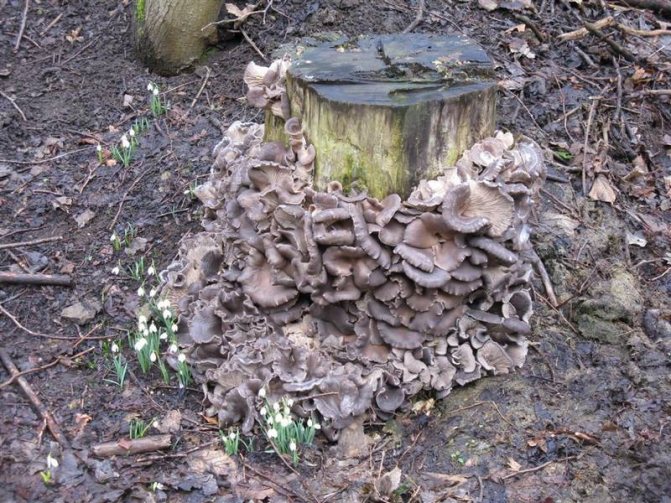

Photo Credit: M J Richardson, CC BY-SA 2.0
Preparing a substrate for growing oyster mushrooms
Nowadays, people increasingly value food products not only for their taste, but also for their environmental friendliness. For growing oyster mushrooms at home, it excludes the content of nitrates and harmful substances. Oyster mushrooms have a beneficial effect on the human body, they are recommended for hypertensive patients, the risk of cancer is reduced, and the level of lipids in the blood is normalized.
It is recommended to use straw of various cereals (barley or wheat) for the substrate. It must be clean and dry, odorless and free of impurities. The straw of these crops is considered the most common raw material for these mushrooms.
When preparing a substrate for growing oyster mushrooms, straws should be selected that are not infected, porous and wide. They need to be crushed or flattened. Straw should be purchased from one vendor. If it is fresh, has a thick coating of wax, then it must be soaked for 12 hours.
At home, hydrothermal treatment is often used. A large-volume container is taken, straw is compacted into it. It is filled with warm water and then heated to 70 degrees.At a steady temperature, the substrate must be kept for about 3 hours, then the water must be drained. Next, the substrate is removed by removing excess water. When its temperature reaches 25 degrees, you can proceed to planting.
The straw cools down for about half an hour. During this time, it is required to prepare the mycelium, a polyethylene bag, and the site of inoculation. The substrate is poured to the bottom of the bag, then a layer of mycelium is laid out. The procedure is repeated until the package is completely filled. Mycelium should be no more than 5% by weight of the substrate.
Sometimes in order to grow oyster mushrooms, sunflower husks are used. It must be heated very quickly to 90 degrees, and kept for no more than 2 hours. Then drain the water, wait until the substrate is drained (no more than half an hour), and then inoculate.
It is not so difficult to grow these mushrooms at home. When breeding them, there are a few rules to keep in mind. First, the mycelium must be dispersed so that 4/5 is closer to the sides of the bag. Secondly, the number of layers should not be less than 12. A larger number of them will accelerate the overgrowth of the substrate with mycelium.
After the tamping is finished, you need to leave a little room for the tie. The block (a bag containing mycelium and substrate) must be left in a dark place with a temperature of 20 ° C. If the temperature rises by more than 4 ° C, then the mycelium may die (inside the substrate, the temperature can reach 35 ° C).
If everything is done correctly, then after a maximum of 16 days the block will look like a white monolith. If some areas are infested, the overall yield will be lower. Until primordia appear, you just need to maintain the desired humidity, temperature, sometimes you can spray the block.
Video: Preparing a substrate for mushrooms
Within two days, primordia become adult mushrooms. In the process of their growth, it is important to monitor the ventilation in the room. It is not necessary to water the rudiments of the mushrooms, this can cause their death. You can harvest when the edges are aligned on the caps at the top of the splice.
Below you will learn how to make oyster mushroom mycelium at home and how to grow mushrooms.
Interesting facts about oyster mushroom
- Ishiven - this was the name of the oyster mushroom in Russia in the past. It has been known about its taste for a long time, but they began to grow oyster mushrooms relatively recently. Today, their production is in second place after champignons.
- The Germans began to grow oyster mushrooms in large quantities in the hungry years after the First World War. They were joined by French mushroom growers. But industrial breeding of oyster mushrooms in Europe was started only in the 60s of the XX century. In Hungary, at the first large-scale production, these mushrooms began to be grown according to developed technologies under special conditions. Gradually, the experience of the Hungarians began to be adopted in Spain, Italy, and later in America.
- In New Zealand, the law prohibits the cultivation and import of oyster oyster into the country. Here it is considered a parasitic fungus that can have a harmful effect on the local flora. It's a paradox, but dishes are very popular in local cuisine, one of the ingredients of which is pulmonary oyster mushroom.
- Oyster mushrooms can be called predatory mushrooms. They secrete a nematotoxin that paralyzes nematodes (primary cavity worms). Thus, the mushrooms receive the nitrogen they need for growth.
- Only young oyster mushrooms are used in cooking. As mushrooms grow, they lose their taste and become tough, so it is undesirable to eat them. Oyster mushrooms can be stored in the refrigerator for no more than 3 days.
- The spores that mushrooms use to reproduce are usually carried by the wind. In calm weather, mushrooms are capable of emitting water vapor. It creates light currents of air that pick up tiny spores and carry them to new locations. For the first time this phenomenon was studied on the example of common oyster mushroom.
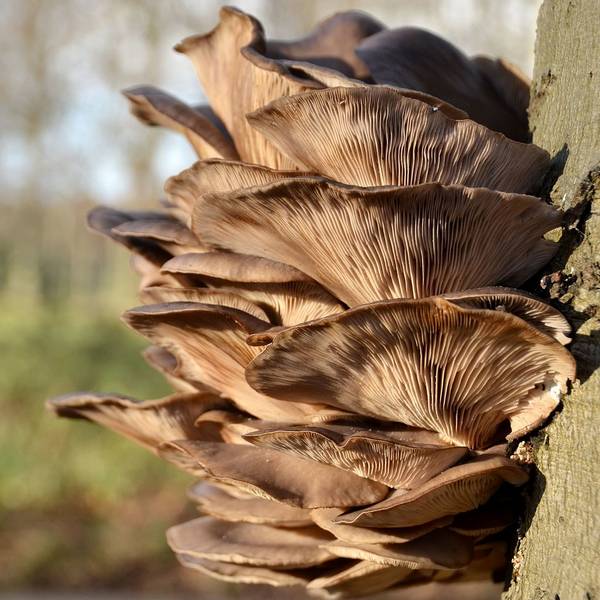

Photo by: Henk Monster, CC BY 3.0
Did you like the article?
Technology of growing oyster mushrooms on grain
In the modern world, grain or uterine mycelium of oyster mushrooms is used for the reproduction of mushrooms. It is usually grown under sterile laboratory conditions to keep the mycelium from harmful microorganisms and increase yields. But amateur mushroom growers have found a way to create it at home. Moreover, home mycelium bears fruit no worse than laboratory.
Mycelium using oatmeal. You will need to take:
- 40 grams of flakes crushed to a mealy state;
- 960 ml of water;
- 100 grams of gelatin;
- germicidal lamp;
- sterilized test tubes and cotton "plugs" to them;
- grain jars, tweezers;
- mature oyster mushroom.
Boil oatmeal for an hour, then strain through several layers of gauze. Soak the gelatin in water (take part of the already prepared water) and, when it swells, heat it up in a water bath, then add it to the oatmeal jelly. Fill the tubes with the resulting gruel by 2/3 of the total volume, close them with cotton plugs and put them to sterilize in a water bath for 40 minutes. Next, you will need to set the tubes in an inclined state so that the inoculated area becomes larger. When the substance in the test tubes has cooled, take a plate of oyster mushroom (the part that grows under the mushroom cap) with sterilized tweezers and gently place it in test tubes on a nutrient medium. Close the tubes with cotton stoppers and wrap with foil. Remove tubes in a dark place with a temperature of at least 24 ° C. After 2 weeks, the mycelium will be ready.
This mycelium will need a grain substrate. To prepare it you will need:
- 10 kg of grain (any grain crop);
- 15 liters of water;
- 130 g of gypsum;
- 30 g of chalk.
Boil the grain in water until it becomes soft, but do not boil it into porridge. You should dry the boiled grain well and add gypsum and chalk to it. Fill the jars with the prepared grain, making a small indentation inside in order to place the mycelium in the future. It is necessary to make a hole with a diameter of 1.5 cm in the lids, and then close the jars with them. Plug the holes in the lids with cotton swabs. Sterilize in an oven at 120 ° C for two hours.
Now it remains to plant a little oyster mushroom mycelium in the prepared grain substrate. It is necessary to slightly heat the tubes with the mycelium ready for planting so that it can easily detach from the walls. Using sterilized tweezers, carefully transfer the oyster mushroom mycelium from the test tube into the well prepared on the grain. It is important to close the openings in the lids again with cotton plugs and send the jars to a dark place and remember to keep the room temperature at 24 ° C. Observance of sterility when growing oyster mushrooms on grain is very important throughout the entire procedure from start to finish. Only in this case the mycelium will give high yields for a long time.
Video: How to make grain mycelium
Oyster mushroom
The mushroom has a funnel-like shape. The color of the mushroom is light pale. The edges of the cap are often wavy.
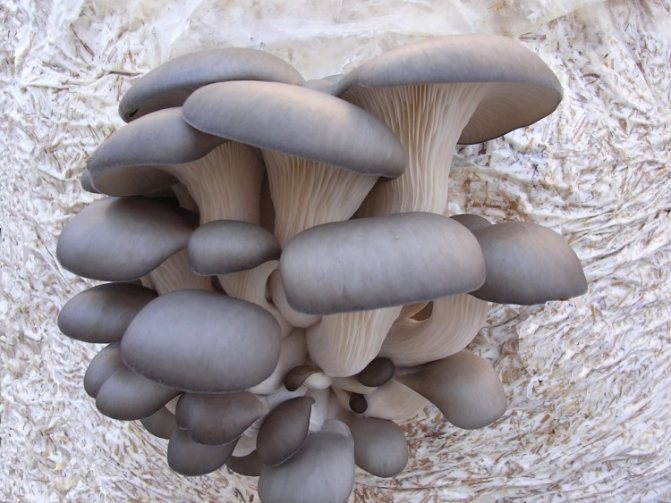

The leg is light in color, gradually decreasing in diameter closer to the soil level. Oyster mushroom has a lot of white pulp and smells a bit like flour.
We recommend reading! Truffle mushrooms: species, description of where they grow, features of collection and use in cooking (110 photos)
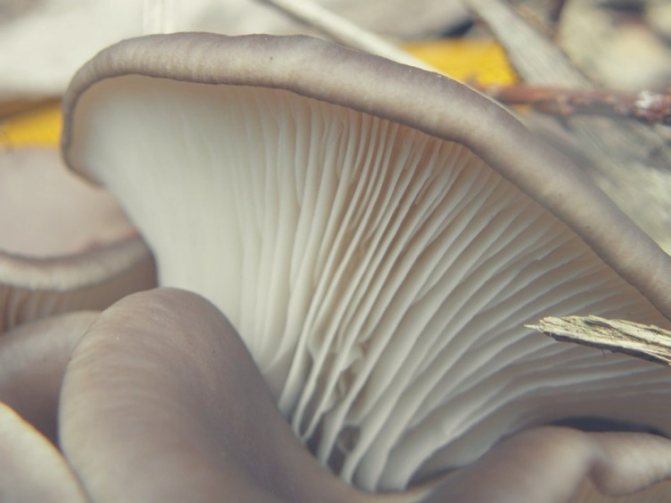

Fruiting of horn-shaped oyster mushroom, as a rule, occurs at the end of May. The fungus grows on stumps of various deciduous tree species.
Autumn oyster mushroom
The hat of this species is rather dark in color. The mushroom has a lot of pulp. The outer side has a small layer resembling fine fluff. The leg has a lateral shape, it is distinguished by a yellow-brown color.


Fruiting of the mushroom begins closer to October and lasts until the beginning of winter.
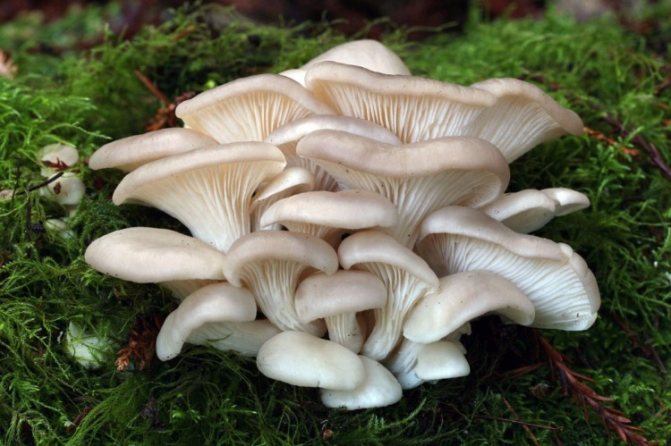

Methods for storing oyster mushroom mycelium
To date, there are two ways to store oyster mushroom mycelium. Both of them are usually used in large industries.This is storing the mycelium in the cold and placing it in liquid nitrogen.
The first method involves placing the oyster mushroom mycelium in the refrigerator. The disadvantage of this method is the difficulty in recognizing the active structure. Therefore, before use, the mycelium is taken out of the refrigerator, shaken vigorously and left at room temperature for several days. The active mycelium will begin to grow rapidly, while the spoiled grain will remain bare and unpleasantly brown in color.
A better way to preserve oyster mushroom mycelium is to place it in liquid nitrogen. In addition to the fact that this substance allows you to well preserve the structure in which oyster mushrooms will grow in the future, it favorably affects the quality of the final product and the productivity of the mycelium.
Before laying the mycelium for storage, it is kept for several days at a temperature of about 5 degrees Celsius. The freezing process itself is carried out very slowly and under close control. Before planting, the mycelium is slowly thawed.
As laboratory experiments show, it is best to store mycelium in liquid nitrogen, since with this method practically no changes occur and all its properties remain almost the same as before storage.
At home storage of mycelium, a freezer is best suited, the temperature in which is minus 20 degrees Celsius. As the practice of experienced mushroom growers shows, such storage allows you to get material of good quality by the required time without any significant changes. After a short rest time, when the mycelium is at room temperature, the structure continues to vegetate.
Only a multiple change of the temperature regime, which results in thawing and repeated freezing of the material, can lead to a deterioration in its qualities, which, of course, does not contribute to the high yield of oyster mushrooms. Therefore, it is very important for the mushroom grower to provide a stable temperature for the stored mycelium, regardless of factors and environmental conditions. Especially if the production of mushrooms is put on stream and is the main source of income.
Getting oyster mushroom mycelium at home is the dream of any mushroom grower. Nowadays it is not difficult to buy it. However, it is not always possible to find a company that is 100% responsible for the quality of products. The fact is that such organizations work mainly with wholesalers and practically do not have time to monitor quality in such conditions.
You can learn about the "inoperability" of the product only when the bags with the substrate turn green. And the cultivation of oyster mushrooms takes a certain amount of time, and 40% of the costs are spent on the substrate. In this case, mushroom growers, not trusting unknown producers, grow mycelium with their own hands.

